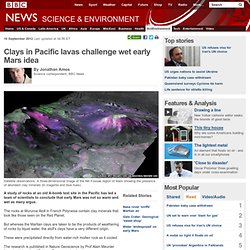

Early Mars not Hospitable? New Mars theory cast doubt on planet's habitability - latimes.com A study of clays suggests they might have been formed in hot magma rich in water — too hot to support microbial life.

A Caltech planetary geologist is coauthor. A standing theory about water on Mars is linked to blueberry-shaped formations in the Martian soil, such as this one in an image captured by the rover Opportunity and released in 2004. An alternate theory published Sunday in the journal Nature Geoscience argues, however, that Martian water's source water would have been far too hot to support microbial life.
(NASA/JPL/U.S. Clays in Pacific lavas challenge wet early Mars idea. 10 September 2012Last updated at 04:50 ET By Jonathan Amos Science correspondent, BBC News.

New Mars theory cast doubt on planet's habitability. A new theory is pouring some cold — actually, some really hot — water on the idea that Mars could have been habitable in the past.

Planetary scientists searching the Red Planet for places that could have contained the building blocks for life look for clues in clays, which can offer some indication that water must have flowed on or just under Mars' surface. But a new study suggests that, at least in some cases, those clays might be a red herring. A paper published online Sunday by the journal Nature Geoscience argues that such clays might have been formed in hot Martian magma rich in water. If so, that water would have been far too hot to support microbial life. PHOTOS: Inside the Mars landing The argument stands in contrast to two more common theories, said study coauthor Bethany Ehlmann, a planetary geologist at Caltech. On Earth, clays are remarkably good at trapping organic material. "The clays would form as the lava cools from 1,500 degrees Celsius," she said.
Amina.khan@latimes.com. Early Mars Maybe Not So Wet. Early Mars may not have been as warm or wet as scientists suspect, a finding which could impact the likelihood that the Red Planet was capable of evolving life at the time when it was getting started on Earth.

A new study presents an alternative explanation for the prevalence of Mars' ancient clay minerals, which on Earth most often result from water chemically reacting with rock over long periods of time. The process is believed to be a starting point for life. The clays, also known as phyllosilocates, are among the strongest pieces of evidence for a Mars that once was warmer, wetter and much more like Earth than the cold, dry, acidic desert which appears today. Study suggests early Mars was not so wet › News in Science (ABC Science) News in Science Monday, 10 September 2012 Irene KlotzDiscovery News.

Mars Clays May Have Volcanic Source. Mars' History Is A Fluid Situation. Clay Deposits Don’t Prove Existence of Ancient Martian Lakes. Want to stay on top of all the space news?

Follow @universetoday on Twitter HiRISE image of branching features in the floor of Antoniadi Crater thought to contain clay material. (NASA/JPL/University of Arizona) Early Mars may not have been hospitable after all: study. Instead of a warm, wet and possibly life-bearing planet as some scientists contend, early Mars may have been a hostile and volatile place with frequent volcanic outbursts, a study said Sunday.

Earlier research had theorised that certain minerals detected on the surface of the Red Planet indicated the presence of clay formed when water weathered surface rock some 3.7 billion years ago. This would also have meant the planet was warmer and wetter then, boosting chances that it could have nurtured life forms. But new research by a team from France and the United States said the minerals, including iron and magnesium, may instead have been deposited by water-rich lava, a mixture of molten and part-molten rock beneath Earth's surface.
Alain Meunier of France's Universite de Poitiers and a team studied clay minerals at Mururoa atoll in French Polynesia that seem similar to martian examples, and showed they were formed from precipitation of lava. "Magmatic clays have no climatic significance. Not so moist Mars: Clays may come from lava, not lakes - space - 09 September 2012. Hunting for Martians may be a tougher task than predicted.

Clays, long thought to be a sure sign of a warmer and wetter past on the Red Planet, could merely signal earlier volcanic activity – which would have made some regions on Mars less favourable for life. Clay layers found across Mars suggest that during the Noachian period, from about 4.2 billion to 3.5 billion years ago, the planet was warm enough to host liquid water – necessary for life as we know it. Mars Express Provides Deeper Understanding of Red Planet by VR. The European Space Agency's Mars Express, after taking some time out to assist in the recent landing of NASA's Curiosity rover, has returned to its primary mission of studying the diverse geology and atmosphere of the 'Red Planet' from orbit.

Earlier in 2012, the craft observed the 120 km wide Hadley Crater, images of which provide evidence of multiple subsequent impacts within the main crater wall, reaching depths of up to 2600 m below the surrounding surface. This region imaged on 9 April 2012 by the High Resolution Stereo Camera on Mars Express shows the crater which lies to the west of the Al-Qahira Vallis in the transition zone between the old southern highlands and the younger northern lowlands. Hadley is named after George Hadley (1685-1768), British lawyer and meteorologist, whose name was also given to the 'Hadley cell', a circulation system in Earth's atmosphere, which transports heat and moisture from the tropics up to higher latitudes. Nadine will form soon, interesting map of storm enhancing hot waters. Fascinating new story about Mars. « coastlinesproject.
By Jonathan AmosScience correspondent, BBC News Satellite observations: A three-dimensional image of the Nili Fossae region of Mars showing clays presence of abundant cllays minerals (in magenta and blue hues) A study of rocks at an old A-bomb test site in the Pacific has led a team of scientists to conclude that early Mars was not so warm and wet, as many argue.

The rocks at Mururoa Atoll in French Polynesia contain clay minerals that look like those seen on the Red Planet. But whereas the Martian clays are taken to be the products of weathering of rocks by liquid water, the atoll’s clays have a very different origin. These were precipitated directly from water-rich molten rock as it cooled. The research is published in Nature Geoscience by Prof Alain Meunier from the University of Poitiers, France, and colleagues.